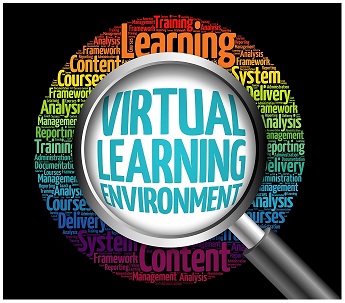What is 3D multiuser virtual environment
3D multiuser virtual environment (MUVE) is a virtual world where people can communicate with each other in a way that resembles communication in the real world. The users, depicted by avatars, can move about freely and communicate with each other vocally, as well as by means of text messages or video conferencing. It allows communications between more people in real time which means the principle of social network transferred into virtual reality. The advantage of this model is its orientation on the student, the revolutionary broadening of possibilities in the use of computer technologies within the teaching environment. 3D virtual model enables 3D visualised teaching where the authors try to simulate the environment graphically in such a way that would resemble a common school building with classrooms, a library, a place where students can meet etc.
The added value for both the teacher and student is the possibility of equipping the classrooms exactly for teaching specialised subjects (where, in reality, it is often not possible for economic or other reasons) or for training skills which would not be possible to do in normal classes because of safety reasons or cost (for example, learning to fly a plane or carrying out brain surgery). A great advantage of using MUVE, at least as a supplement for present e-learning forums, is providing the feeling of social interaction, feeling of belonging and immersion, thus enhancing the motivation of the student. The feeling of having spent time together in a commonly shared space is also enhanced by using non-verbal communication including proximity. Avatars can approach each other, form discussion groups, use gestures, haptics, and are also able to use facial expressions in a limited way.
Many universities have discovered the possibilities of MUVE and have built the virtual campuses in MUVE. We can currently find more than 60 American higher education institutions, such as Harvard University, University of Plymouth, Ohio University, British Universities such as Oxford University, Coventry University and so on. In the Czech Republic, MUVE was initially used also by universities (Mendel University of Agriculture and Forestry, Brno and the Philosophical Faculty and Faculty of Education of the Palacky University, Olomouc). This environment provides a great advantage to both Czech and foreign universities in terms of the possibility of mutual interconnection, as well as interconnection with other scientific workplaces. The result of this is the sharing of information, research results, and the possibility of mutual help at solving problems. MUVE is currently used especially for language education because it enables the participants to meet with people who speak in different mother tongues and also because many more computer devices can be utilized than in a traditional class setting. MUVE can be used not only in relation to language learning but to illustrate a certain phenomenon, or to examine the relationships between them.
The pros and cons of using MUVE
As discussing the suitability of MUVE in education it is necessary to introduce the pros and cons of its use. The most frequently mentioned benefits in the current literature are the following:
1) Gamification (school game) which allows playfully perform tasks that may be seem boring in „traditional“ teaching and should be consider as based on the pedagogical principle of project teaching.
2) Immersion which allows to empathize better with the situation and can be consider as based on the pedagogical principles of situational learning or experiential learning.
3) Creativity which means working with 3D objects and create them in a virtual environment. It allows students to access learning creatively (e.g. in teaching architecture and geometry etc.).
4) Time and space-saving which means a very flexible, fast editable environment. The learning objects can be created very cheap comparing to the similar objects in real-life situations. Teaching takes place regardless of the particular time and space as well.
5) Social networking which means that MUVE is the same type of social networks with communication options similar to the traditional social networks (e.g. Facebook). Communication takes place in 3D simulation of the real world, which strengthens the aspect of social contact.
6) Crowdsourcing means that MUVE gives the opportunity to obtain answers to learning questions not only from users with superior authority (mostly the teachers), but in a community of other users (e.g. classmates). In the community of users with similar interests can draw additional suggestions or users can find already created materials and objects.
The most common disadvantages of use MUVE in education are the following:
1) Health risks (eyesight, musculoskeletal system etc.)
2) Increasing of ICT addiction of users
3) Reducing of social contact in the real world
4) Dependency on the condition of technical equipment
5) Dependency on the digital competences of students or teachers which can have an impact on the overall performance or the teaching results.
6) The digital gap between teachers and students ICT competences levels

